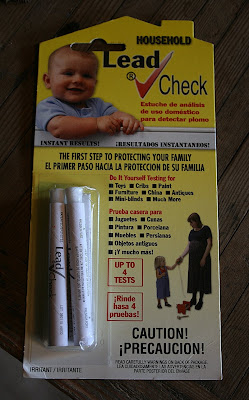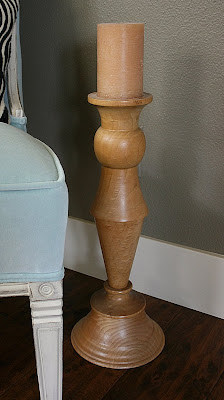
So off I went to Home Depot and bought a lead test kit. Yes, just as I had started to suspect, this cabinet had been painted with lead paint. I really wanted to cry. And then the debate in my head began. Do I get rid of it a fast as possible or do I find a way to remove the paint safely? My first reaction was to dispose of the piece quickly, but the thought of doing this made me even more upset.

This cabinet has history. I have some wonderful memories hanging out in the shop with my grandfather, dad and brothers, watching some beautiful things being made. My grandfather died many years ago, so these memories are precious. How can I just throw away an item that connects me back to those times?

I went around the house today and was surprised at how many wooden candlestick holders and bowls, which were made in the woodshop, are placed here and there around my home. The pieces are really quite beautiful.




After thinking about it for a couple days, making calls and researching ways to deal with lead paint I was referred to Houck's Process Stripping Center. This is an EPA approved stripping center located here in Portland. My friend and fellow designer, Dianne of simplydesign, helped me look into this. She has experience dealing with the issue of lead paint, as her previous home was built in the early 1900's. Here is the advice we received.
Steven, an architect, wrote, "I think she has two choices":
1. Strip the paint off herself or have it done at a place like Houck’s. This is where I took my doors.
2. Paint over the existing paint. Simply painting would encapsulate it. Not sure she would need to seal it first? However, I would recommend a good primer that would ensure her new coat of paint sticks properly.
Another architect Allen wrote:
"If she chooses to paint over it a sealing oil-based primer would be a good idea. I would recommend stripping if possible - the finish will be much better if the old paint is removed, and she can avoid sanding which is not a good idea with lead paint. I don't know any places that strip other than the one Steven mentioned. If she wants to do it herself it's not difficult, just time consuming. They sell everything she'll need at Home Depot, and she can call Metro to find out where to get rid of the stripped paint."
I can bet this is not the first time I've dealt with a piece of furniture with lead paint on it. This is simply the only time I've been aware of it. I think back to several pieces I've refinished, without a single thought as to whether or not the original paint was lead. As a result I've probably had more exposure than is wise...so this time around I'm leaving this job to the pros and calling Houck's!
No comments:
Post a Comment